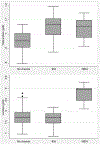Buffered or impaired: Maternal anemia, inflammation and breast milk macronutrients in northern Kenya
- PMID: 30575959
- PMCID: PMC6352968
- DOI: 10.1002/ajpa.23752
Buffered or impaired: Maternal anemia, inflammation and breast milk macronutrients in northern Kenya
Abstract
Background: Maternal anemia has adverse consequences for the mother-infant dyad. To evaluate whether and how milk nutrient content may change in ways that could "buffer" infants against the conditions underlying maternal anemia, this study assessed associations between milk macronutrients and maternal iron-deficiency anemia (IDA), non-iron-deficiency anemia (NIDA), and inflammation.
Methods: A secondary analysis of cross-sectional data and milk from northern Kenya was conducted (n = 204). The combination of hemoglobin and transferrin receptor defined IDA/NIDA. Elevated serum C-reactive protein defined acute inflammation. The effects of IDA, NIDA, and inflammation on milk macronutrients were evaluated in regression models.
Results: IDA (β = 0.077, p = .022) and NIDA (β = 0.083, p = .100) predicted higher total protein (ln). IDA (β = -0.293, p = .002), NIDA (β = -0.313, p = .047), and inflammation (β = -0.269, p = .007) each predicted lower fat (ln); however, anemia accompanying inflammation predicted higher fat (β = 0.655, p = .007 for IDA and β = 0.468, p = .092 for NIDA). NIDA predicted higher lactose (β = 1.020, p = .003).
Conclusions: Milk macronutrient content both increases and decreases in the presence of maternal anemia and inflammation, suggesting a more complicated and dynamic change than simple impairment of nutrient delivery during maternal stress. Maternal fat delivery to milk may be impaired under anemia. Mothers may buffer infant nutrition against adverse conditions or poor maternal health by elevating milk protein (mothers with IDA/NIDA), lactose (mothers with NIDA), or fat (mothers with anemia and inflammation). This study demonstrates the foundational importance of maternal micronutrient health and inflammation or infection for advancing the ecological understanding of human milk nutrient variation.
Keywords: C-reactive protein; infection; iron-deficiency anemia; non-iron deficiency anemia; transferrin receptor.
© 2018 Wiley Periodicals, Inc.
Conflict of interest statement
References
-
- Antelman G, Msamanga GI, Spiegelman D, Urassa EJ, Narh R, Hunter DJ, & Fawzi WW (2000). Nutritional factors and infectious disease contribute to anemia among pregnant women with human immunodeficiency virus in Tanzania. The Journal of Nutrition, 130(8), 1950–1957. - PubMed
-
- Aumeistere L, Ciproviča I, Zavadska D, & Ceļmalniece K (2017). Lactose content of breast milk among lactating women in Latvia. 2255-9817. Proceedings from Foodbalt 2017: 11th Baltic conference on food science and technology, Jelgava Accessed at: http://agris.fao.org/agris-search/search.do?recordID=LV2017000292.
-
- Bachour P, Yafawi R, Jaber F, Choueiri E, & Abdel-Razzak Z (2012). Effects of smoking, mother’s age, body mass index, and parity number on lipid, protein, and secretory immunoglobulin A concentrations of human milk. Breastfeeding Medicine, 7(3), 179–188. - PubMed
Publication types
MeSH terms
Substances
Grants and funding
LinkOut - more resources
Full Text Sources
Research Materials



